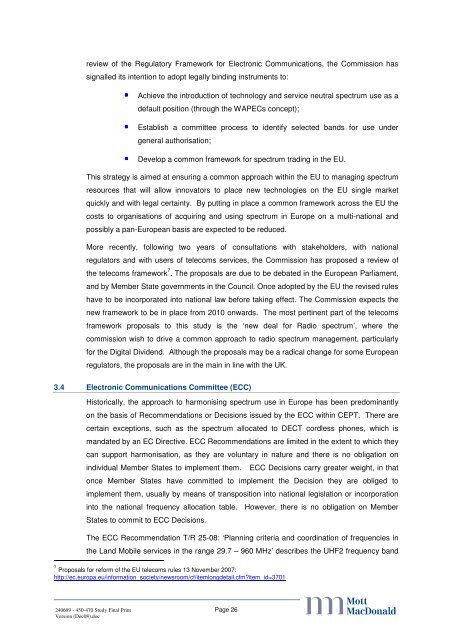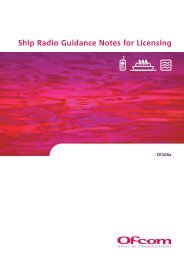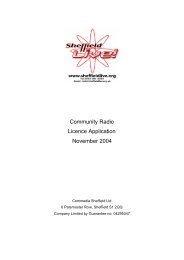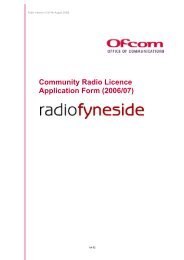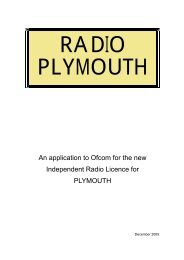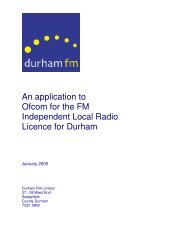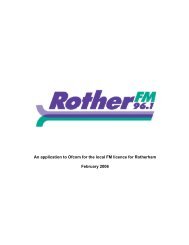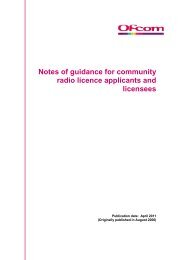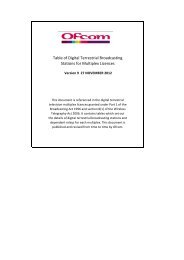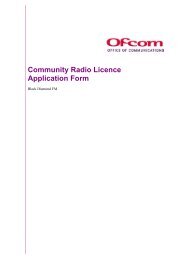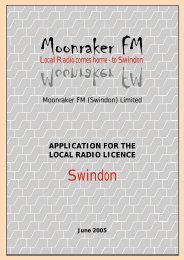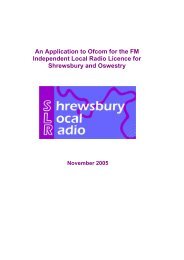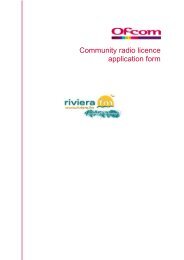UHF2 realignment study - Ofcom Licensing
UHF2 realignment study - Ofcom Licensing
UHF2 realignment study - Ofcom Licensing
Create successful ePaper yourself
Turn your PDF publications into a flip-book with our unique Google optimized e-Paper software.
eview of the Regulatory Framework for Electronic Communications, the Commission has<br />
signalled its intention to adopt legally binding instruments to:<br />
240689 - 450-470 Study Final Print<br />
Version (Dec08).doc<br />
Achieve the introduction of technology and service neutral spectrum use as a<br />
default position (through the WAPECs concept);<br />
Establish a committee process to identify selected bands for use under<br />
general authorisation;<br />
Develop a common framework for spectrum trading in the EU.<br />
This strategy is aimed at ensuring a common approach within the EU to managing spectrum<br />
resources that will allow innovators to place new technologies on the EU single market<br />
quickly and with legal certainty. By putting in place a common framework across the EU the<br />
costs to organisations of acquiring and using spectrum in Europe on a multi-national and<br />
possibly a pan-European basis are expected to be reduced.<br />
More recently, following two years of consultations with stakeholders, with national<br />
regulators and with users of telecoms services, the Commission has proposed a review of<br />
the telecoms framework 7 . The proposals are due to be debated in the European Parliament,<br />
and by Member State governments in the Council. Once adopted by the EU the revised rules<br />
have to be incorporated into national law before taking effect. The Commission expects the<br />
new framework to be in place from 2010 onwards. The most pertinent part of the telecoms<br />
framework proposals to this <strong>study</strong> is the ‘new deal for Radio spectrum’, where the<br />
commission wish to drive a common approach to radio spectrum management, particularly<br />
for the Digital Dividend. Although the proposals may be a radical change for some European<br />
regulators, the proposals are in the main in line with the UK.<br />
3.4 Electronic Communications Committee (ECC)<br />
Historically, the approach to harmonising spectrum use in Europe has been predominantly<br />
on the basis of Recommendations or Decisions issued by the ECC within CEPT. There are<br />
certain exceptions, such as the spectrum allocated to DECT cordless phones, which is<br />
mandated by an EC Directive. ECC Recommendations are limited in the extent to which they<br />
can support harmonisation, as they are voluntary in nature and there is no obligation on<br />
individual Member States to implement them. ECC Decisions carry greater weight, in that<br />
once Member States have committed to implement the Decision they are obliged to<br />
implement them, usually by means of transposition into national legislation or incorporation<br />
into the national frequency allocation table. However, there is no obligation on Member<br />
States to commit to ECC Decisions.<br />
The ECC Recommendation T/R 25-08: ‘Planning criteria and coordination of frequencies in<br />
the Land Mobile services in the range 29.7 – 960 MHz’ describes the <strong>UHF2</strong> frequency band<br />
7 Proposals for reform of the EU telecoms rules 13 November 2007:<br />
http://ec.europa.eu/information_society/newsroom/cf/itemlongdetail.cfm?item_id=3701<br />
Page 26<br />
abc


